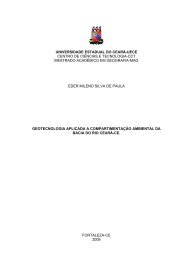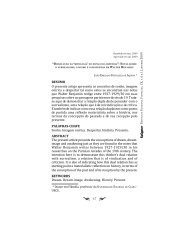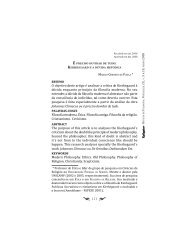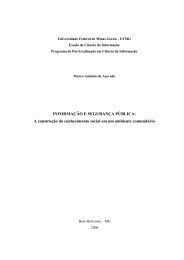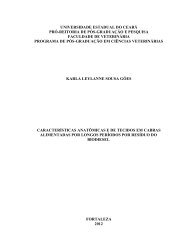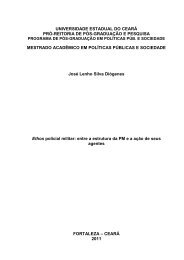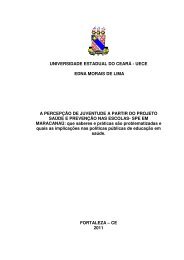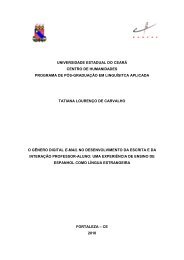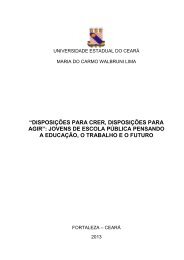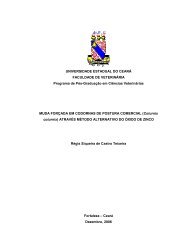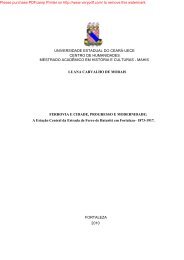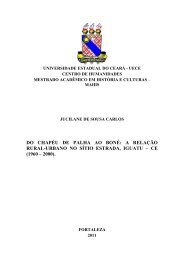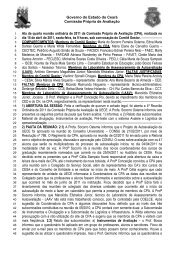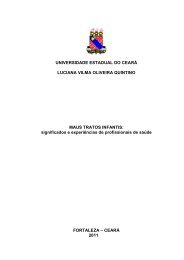Avaliação da temperatura, umidade e vacinação in ovo
Avaliação da temperatura, umidade e vacinação in ovo
Avaliação da temperatura, umidade e vacinação in ovo
You also want an ePaper? Increase the reach of your titles
YUMPU automatically turns print PDFs into web optimized ePapers that Google loves.
ABSTRACT<br />
Incubation is fun<strong>da</strong>mental to expansion and ma<strong>in</strong>tenance of quail production. This<br />
research aimed to study factors that <strong>in</strong>fluence on performance of Japanese quail<br />
<strong>in</strong>cubation: temperature, humidity and <strong>in</strong> <strong>ovo</strong> vacc<strong>in</strong>ation. Three experiments were<br />
carried out. The first verified the effects of temperatures on hatchability, hatch weight,<br />
hatch time and embryo mortality. 800 eggs were divided <strong>in</strong>to eight experimental groups<br />
<strong>in</strong>cubated at different temperatures (34, 35, 36, 37, 38, 39, 40 and 41ºC). The other<br />
<strong>in</strong>cubation conditions were identical for all groups, 60±5% of relative humidity and egg<br />
turn<strong>in</strong>g every two hours until transference. The second experiment aimed to verify the<br />
effect of relative humidity dur<strong>in</strong>g <strong>in</strong>cubation of Japanese quail eggs on hatchability, egg<br />
weight loss, hatch weight, and embryo mortality. 300 eggs were divided <strong>in</strong>to three<br />
experimental groups: low humidity (36.05%), <strong>in</strong>termediate (52.25%) and high<br />
(76.50%). The other <strong>in</strong>cubation conditions were identical for all groups, 37.5°C of<br />
temperature and egg turn<strong>in</strong>g every 30 m<strong>in</strong>utes until transference. The third experiment<br />
aimed to evaluate the effects of <strong>in</strong> <strong>ovo</strong> vacc<strong>in</strong>ation procedures on <strong>in</strong>cubation of Japanese<br />
quail eggs. The experiment was carried out <strong>in</strong> a factorial design (4x4) with 17<br />
experimental treatments (4 <strong>in</strong>jection <strong>da</strong>ys x 4 <strong>in</strong>jection protocols, plus 1 control group).<br />
The <strong>in</strong>jections were tested at four <strong>in</strong>cubation <strong>da</strong>ys: at 0, 5, 10 or 15. At each <strong>da</strong>y, the<br />
eggs were submitted to four dist<strong>in</strong>ct <strong>in</strong>jection procedures: sal<strong>in</strong>e <strong>in</strong>jection with or<br />
without egg seal<strong>in</strong>g and Newcastle disease (ND) vacc<strong>in</strong>e plus sal<strong>in</strong>e or <strong>in</strong>dustrial<br />
diluent, both without seal<strong>in</strong>g. The eggs were <strong>in</strong>cubated at 37.5º C and 60% RH. All eggs<br />
and hatched quails were weighted. Unhatched eggs were opened to classify embryo<br />
mortality. Hatched quail were bled to evaluate antibody response. The results showed<br />
that hatchability was higher for eggs <strong>in</strong>cubated at 37 and 38ºC, 76.67 and 80.76%,<br />
respectively. Eggs <strong>in</strong>cubated at 34ºC did not hatch and at 35 and 41ºC showed very poor<br />
hatchability. The other temperatures had hatch rates from 50.33 to 57.73%. There were<br />
higher hatch weights <strong>in</strong> eggs <strong>in</strong>cubated at 38-41°C compared to those at 35-37°C. The<br />
higher temperature became the smaller hatch time was. This relation was observed until<br />
39°C. Embryos seemed to be resistant to embryo death <strong>in</strong> high temperatures until 40°C<br />
at the early period of <strong>in</strong>cubation, however the same was not observed at the later stages<br />
when high temperatures (39-41°C) promoted elevated levels of embryo mortality. It was<br />
verified that Japanese quail eggs <strong>in</strong>cubated at the lower humidity presented the highest<br />
level of hatchability (79%) compared to <strong>in</strong>termediate and high humidities. Egg weight<br />
loss was respectively 11.96%, 8.94%, and 4.89% for low, <strong>in</strong>termediate and high<br />
humidity groups. Furthermore, the weight at hatch was <strong>in</strong>fluenced by the different<br />
humidities. The <strong>in</strong>jection process itself (sal<strong>in</strong>e with/without seal<strong>in</strong>g) was not harmful for<br />
eggs at 10 and 15 <strong>da</strong>ys of <strong>in</strong>cubation for Japanese quail eggs, however <strong>in</strong> <strong>ovo</strong><br />
vacc<strong>in</strong>ation with live ND vacc<strong>in</strong>e (HB1 stra<strong>in</strong>) is not recommended to fertile quail eggs<br />
at any <strong>in</strong>cubation periods due to high levels of embryo mortality and poor post-hatch<br />
antibody titers.<br />
Key words: temperature, humidity, <strong>in</strong> <strong>ovo</strong> vacc<strong>in</strong>ation, Japanese quail, eggs<br />
9



